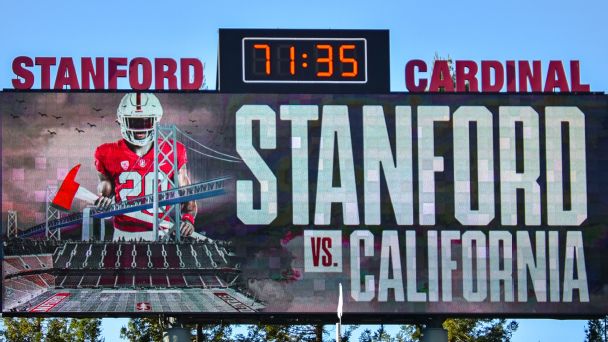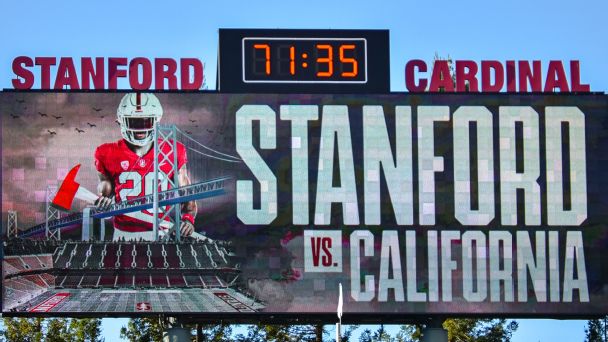
After nearly a month of conversations, the ACC presidents and chancellors voted Friday morning to add Stanford, Cal and SMU, giving the league 18 schools — 17 in football — starting with the 2024-25 season. The protracted conversations gained steam over the past week, as financial models that projected more of a windfall for existing members were enough to garner 12 votes to pass the additions.
The ACC now expands literally from coast to coast, and though there has been pushback on adding teams from several league members — including a pointed statement from the North Carolina board of trustees — the vast majority of presidents ultimately decided this was in the best interest of the ACC, as the SEC, Big Ten and Big 12 have expanded over the past two years. This is, quite frankly, a matter of survival.
So why did this happen and what’s next? ESPN reporters Andrea Adelson, Kyle Bonagura, Heather Dinich, David Hale and Dave Wilson answer those questions and more.
Jump to:
How does this affect FSU, Clemson?
What now for Wazzu and Oregon State?
College Football Playoff impact
Why is the ACC doing this now?
There are two primary reasons for expanding. The first is money. The second is security.
On the financial front, Stanford, Cal and SMU have all agreed to forgo a sizable portion of TV revenue the ACC generates by adding teams. Sources indicated that SMU is expected to take no television money for nine years, while Cal and Stanford are expected to initially join at approximately 30% shares.
That would create a pool of between $50 million and $60 million annually to divide among ACC schools. Some of that would be distributed to all members, and the rest would be put into a pool for success initiatives. Those initiatives, which were passed in May and would begin next season, are based on performance in revenue-generating postseason competition — more specifically, the College Football Playoff and NCAA men’s and women’s basketball tournaments. A larger share of that revenue will go to the teams participating rather than getting divided equally among all members.
This money can alleviate some of the financial stress that has been a dark cloud hanging over the ACC since the SEC and Big Ten inked lucrative new TV deals over the past few years. It’s not a long-term solution, and it certainly doesn’t instantly put ACC teams on par with schools in those other two leagues, but it’s a needed Band-Aid at a time when some programs were making a lot of noise about revenue concerns.
Having said that, Florida State has been pushing for a change in the revenue distribution model when it comes to the current television payouts for existing members. Currently, that money is divided equally among league members. But Florida State athletic director Michael Alford has pushed for that money to be distributed based on each school’s value to the television deal — including ratings, brand and marketability. ACC presidents have not been willing to consider this plan, but that does not mean Florida State will give up the fight to keep pushing for it.
But the fallout for the Pac-12 also offered its own lesson to the rest of the ACC. As one league administrator said, “no one wants to end up like Oregon State and Washington State.” Jim Phillips routinely touted the ACC’s standing as a clear No. 3 in the conference pecking order, but the Big 12 made waves by adding Colorado, Arizona, Arizona State and Utah, and that league also has a chance to negotiate another new TV deal six years before the ACC will. That at least left the door open to a Plan B for schools unlikely to get an offer from the Big Ten or SEC, meaning an all-out collapse of the ACC wasn’t entirely impossible. On the heels of seeing it happen to the Pac-12, a number of ACC presidents wanted assurances against dissolution. Adding three new teams changes the math enough as to make that all but impossible. “It’s strength in numbers,” one AD said and “essentially a math problem,” another added. Even if the big brands ultimately go elsewhere, Stanford, Cal and SMU provide enough of a cushion to keep the league afloat. — David Hale and Andrea Adelson
How does this affect the short- and long-term plans of FSU and Clemson?
The immediate future for Florida State and Clemson was always going to be murky, and this probably doesn’t change that much. But a decision to challenge the ACC’s grant of rights — which gives the league rights to each school’s media packages through 2036 — comes with some serious legal and financial peril. To challenge the document in court isn’t anyone’s idea of an easy exit strategy. It still might be the only long-term option for the biggest brands, but this move could at least delay the process. Each year FSU or Clemson can wait to leave, the cost of doing so gets a little smaller, so if added revenue through expansion helps bridge the short-term gap, the definition of long term gets a little more manageable. As one ACC administrator put it, a lot can change in five years. It’s entirely possible the whole collegiate system looks entirely different by then. Buying time via expansion has real value in allowing schools contemplating departure to get more information about what the future holds before making a final decision. — Hale
How will the ACC address travel and logistical issues?
The ACC has run a number of models looking at ways to reduce travel and limit the impact on its athletes, but the reality is impossible to ignore: Stanford’s campus is 3,100 miles from Miami’s, and nothing the ACC does can shrink that distance. In the end, one administrator said, it’s a trade-off that had to be made. Other conferences are moving to become more national, and the ACC is simply following suit. No one likes the logistical component of cross-country travel, but the extra revenue can at least help make it an easier pill to swallow. — Hale
What’s next for Washington State and Oregon State?
The easiest, most obvious option is probably what will happen: go to the Mountain West as a package deal. Culturally, geographically and — what is shockingly rare in realignment — logically, it just makes sense. The American is an option, too, but even if it is able to distribute more media rights revenue than the MWC, it’s not expected to be enough of an increase that would justify added logistical challenges and expenses of playing all over the country. The most complicated possibility is for the Beavers and Cougars to forge ahead as the two “refounding” members of the Pac-whatever. The thought with this route is that it could possibly allow the schools to claim whatever the conference still has, plus additional units yet to be distributed. The question then becomes who can they get to join? None of the MWC schools could justify leaving on their own and the possibility that nine would vote to dissolve the conference to join WSU and OSU for branding purposes doesn’t make sense. It’s hard to imagine either as an independent in football, either. — Kyle Bonagura
What does no TV revenue mean for SMU?
SMU has been stewing since the Southwest Conference played its last football game in December 1995, when Texas, Texas A&M, Texas Tech and — most galling to the Mustangs — Baylor, a similarly sized private school, ventured north to merge with the Big Eight and form the Big 12. Since then, they’ve seen Gary Patterson win big at TCU and get enough financial backing to storm back into the Big 12. They’ve seen Houston do the same. Only the Mustangs and Rice remain from the SWC’s left-behinds. So they’re taking drastic measures, offering to forgo any television revenue for nine years, and are in the midst of a $250 million athletics makeover, including a $100 million expansion of Gerald J. Ford Stadium, sparked by a $50 million donation by the Garry Weber Foundation, the biggest gift in SMU athletics history. The Mustangs’ 1980s financial flex is now a strength in the modern era of college football, and they’re banking on boosters — who have expressed their willingness to help boost SMU back to the Power 5 — becoming reenergized by a return to big-time football and covering the lack of television revenue they’ll be forgoing by leaving the guaranteed AAC money behind and not getting any in return from the ACC. — Dave Wilson
What comes next for the College Football Playoff?
The CFP’s management committee, which is composed of the 10 FBS commissioners and Notre Dame athletic director Jack Swarbrick, will revisit the format of the 12-team playoff, which begins next season. The current model includes the six highest-ranked conference champions, plus the next six highest-ranked teams, which would typically reward five Power 5 champions, plus a Group of 5 winner. Without the Pac-12, though, they have discussed a 5+7 model, which would include the five highest-ranked conference champions and seven at-large teams. While the idea of 12 at-large teams has been discussed, there doesn’t seem to be much traction for it, though the commissioners didn’t have an in-depth discussion about it yet.
At their most recent in-person meeting in late August, Mid-American Conference commissioner Jon Steinbrecher said moving forward, the principle of honoring conference champions should remain important. “I think that’s a bedrock principle of what we are doing and what we’ve built into this,” he said. “I think it’s important that that is continued as we move forward. Depending on number of conferences we have, I think you can have a legitimate conversation about the number of champions that are set here, as well as the number of at-larges, but to me you start with the bedrock principle and I think it’s important we keep that in there. I felt good coming out of that conversation. Didn’t take any sort of hands, I just felt good about that conversation.”
While the commissioners are expected to have monthly meetings until all of the details to implement the 12-team format are done, their next in-person meeting is later this month at the Big Ten headquarters in Rosemont, Illinois. The ACC’s expansion will also trigger more discussions about how playoff revenue will be distributed. The CFP and ESPN, which is the sole media rightsholder through the duration of the 12-year contract, have to determine if ESPN will remain the lone broadcast partner for the additional games until the contract expires after the 2025 season. — Heather Dinich











